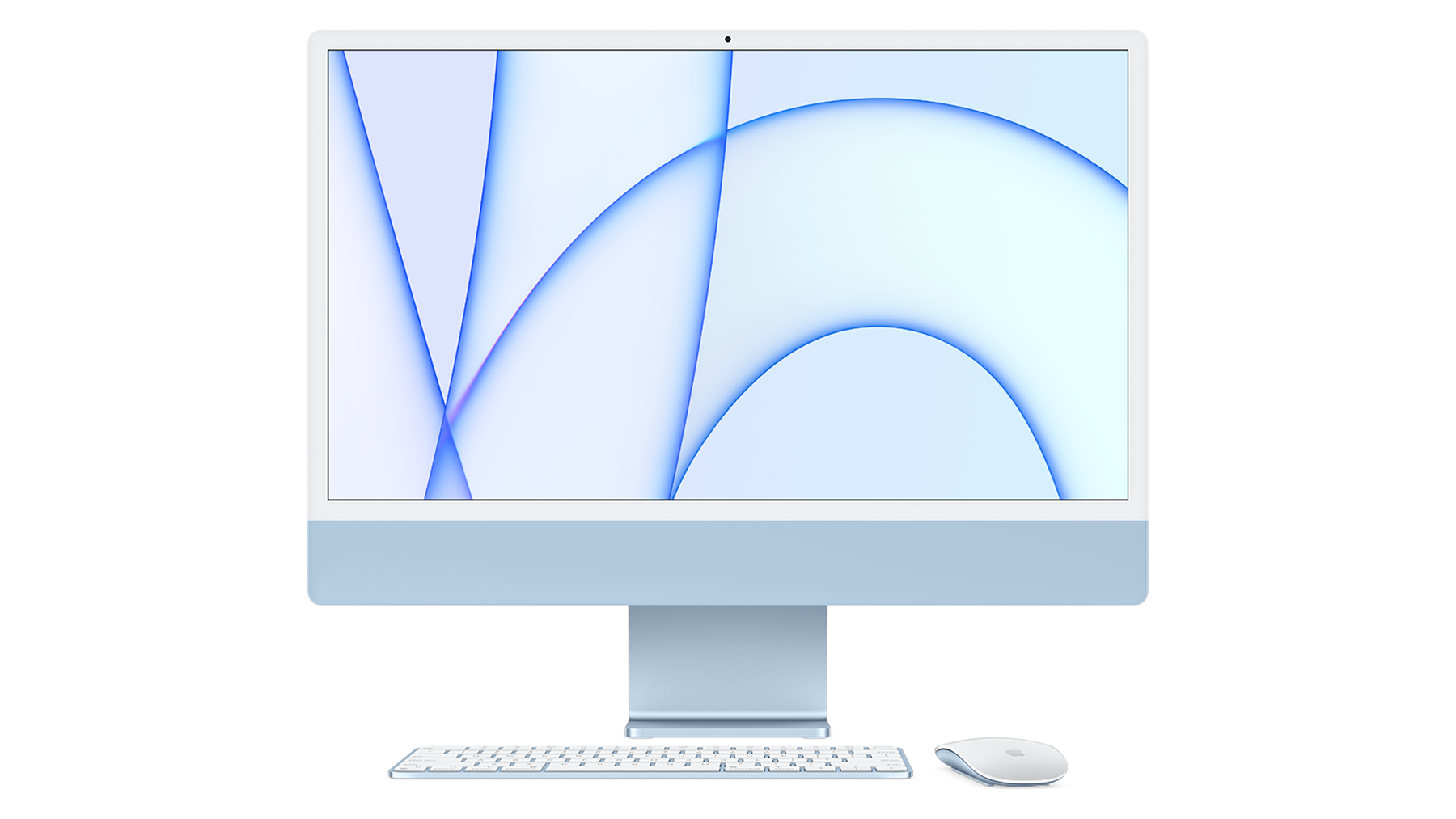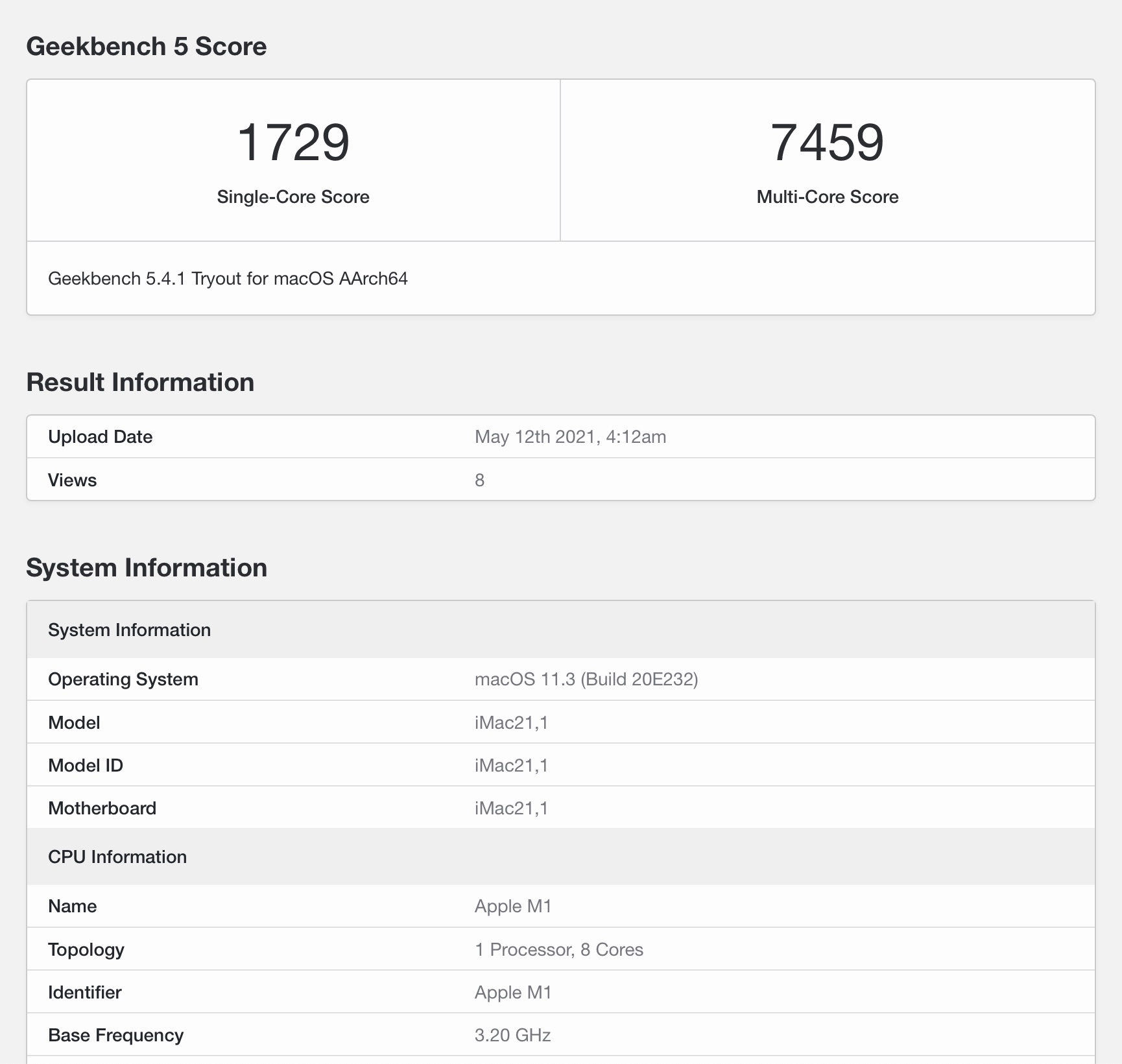but bad for performance? People want the fastest CPUs if its a desktop system
It’s still faster than many an intel processor out there.
but bad for performance? People want the fastest CPUs if its a desktop system
What large group of iMac customers had lower wattage iMac as #1 requested feature on their wish list?
but bad for performance? People want the fastest CPUs if its a desktop system
The Apple hyperbole is that they have conquered almost the whole desktop performance range with just the M1.
What large group of iMac customers had lower wattage iMac as #1 requested feature on their wish list?
That's not an apples to apples comparison either.I mean let’s have some perspective here. This is an Intel 8th gen, the 8700. Desktop chips are on 10th/11th gen now which would be a better comparison.
i7 10700
1262
Single-Core Score
7759
Multi-Core Score
i7 11700
1562
Single-Core Score
9219
Multi-Core Score
This isn’t to say the M1 isn’t competitive because it is, especially when you consider M1 is entry level and sips power. But comparisons like the article aren’t great when the previous model wasn’t refreshed for ages.
20W - 25W - TDP (Not sure on this, I'm sure someone will correct me)
That's kind of what I was trying to point out. The article is comparing an i7 8700 to an M1, the 8700 is a high TDP. If you're going to compare a high TDP to an M1 like this article is, don't use a chip that's from 2017 so you claim "massive performance boosts".That's not an apples to apples comparison either.
It isn't even really Intel's fault. Their architecture was always destined to be replaced eventually. Yes, it is their fault that they slowed down, but they were going to eventually reach the limits of their rather poorly designed architecture, and ARM and other true RISC architectures (x86 is basically RISC, but with legacy CISC baggage) were going to eventually defeat it.Let’s not bash Intel. They did a good job powering the Mac for many years. Quantum leaps like this happen every so often in computing. ARM have done a fantastic job.
I’m tired of your insults. You are now on ignore.Yep, you’ll sadly buy a beige Windows PC.
Well, Intel still sells a chip family they call Pentium for entry level. They even sell some Celery class junk.That's not an apples to apples comparison either.
Here's a better comparison (Geekbench 5)
Intel i3-10100
1101 - Single Core
4048 - Multi Core
75W - TDP
Intel i3-1120G4
1191 - Single Core
2497 - Multi Core
15W - TDP
M1
1729 - Single Core
7459 - Multi Core
20W - 25W - TDP (Not sure on this, I'm sure someone will correct me)
The M1 is entry level. It needs to be compared to other entry level things. But because the M1 smokes all of those people try to see which non entry level things it compates to.
Even still there's a lot on the M1 that is done outside the fire/ice storm cores which doesn't factor into the geekbench score.
The other reason is that users simply don’t (and shouldn’t) care about whether the Apple CPU is low power or not (assuming thermal design was done and battery life isn’t involved). They simply want the speed.I agree within its power class the M1 is astounding.
This article however is comparing big boy Intel powered CPUs so I thought it fair to point out its not exactly fair to look at the 2017 8700 just so we can state big headline performance boosts.
No. People don’t want to have machines that are extreme loud. My 27” iMac started suddenly its fans without apparent reason. Ten minutes later it stopped. This is something that never happens on the M1..The other reason is that users simply don’t (and shouldn’t) care about whether the Apple CPU is low power or not (assuming thermal design was done and battery life isn’t involved). They simply want the speed.
And bad for anyone willing to use the same amount of electricity as a light bulb to get more speed from a CPU.What @theorist9 said, and Apple wants their products to use as little electricity as possible. That's good for batteries, good for your wallet and in larger scales good for the environment as well.
You can use the command line “powermetrics” to see the instantaneous TDP when running. It seems to be about 18 W on the M1 MBA.Apple doesn't really publish a TDP, but it does seem to be somewhere around 15-25W for the M1.
You could tell it’s a Mac by looking at the actual screen, since it would be displaying the Mac interface, that looks nothing like Windows.You think about it too, if the iMac got rid of the chin and the bezels, how would you even know it's an iMac by looking at it? There's a branding issue here. You wouldn't want Mac computers that just look like a monitor. Something about it has to say "iMac". That may sound silly, but design is about a lot of things. Personally, I wanted more of a redesign and the removal of the chins, but I now think who cares. The iMac is a winning design, it's probably a good thing they aren't screwing with it too much.
A $45 liquid cooling setup removes the need for fans at all. Fan noise isn’t a reason to prefer low-power CPUs in a desktop machine that will be plugged in 100% of the time and has no portable/battery operation at all.No. People don’t want to have machines that are extreme loud. My 27” iMac started suddenly its fans without apparent reason. Ten minutes later it stopped. This is something that never happens on the M1..
Yeah, and people will start installing these things into their Macs. This can be done in a custom PC you build yourself. Not on a Mac. Power consumption is important to desktops also. Just not as important as on laptops.A $45 liquid cooling setup removes the need for fans at all. Fan noise isn’t a reason to prefer low-power CPUs in a desktop machine that will be plugged in 100% of the time and has no portable/battery operation at all.
Interesting, but I think that doesn't quite qualify as "TDP".You can use the command line “powermetrics” to see the instantaneous TDP when running. It seems to be about 18 W on the M1 MBA.
Not my point. My point was that Apple could easily have done this and not been concerned with fan noise, regardless of the wattage the CPU pulled or the performance target.Yeah, and people will start installing these things into their Macs. This can be done in a custom PC you build yourself. Not on a Mac. Power consumption is important to desktops also. Just not as important as on laptops.
Well TDP isn’t something that Apple uses either so I was just using the same terminology. If you max out the CPU & GPU cores and look at package power you can watch the max watts. I hit about 18 W and then the MBA starts throttling. So it’s probably a pretty good approximation.Interesting, but I think that doesn't quite qualify as "TDP".
(On my 45 W TDP CPU, if I do exhaust it for a while, it goes to about 37 W. So I guess it works as an approximation.)
Apple's M1 iMacs are set to start delivering to customers next week, and ahead of the official launch day, benchmarks for the machines have been showing up on Geekbench, likely from reviewers who are testing them.

It will come as no surprise that M1 iMac benchmarks are right on par with benchmarks for the M1 MacBook Pro, MacBook Air, and Mac mini, coming in with an average single-core score of 1724 and an average multi-core score of 7453, aggregated from three benchmarks that are currently available.
Benchmarks are for the iMac21,1, which is likely the entry-level option with an 8-core CPU, a 7-core GPU, and two Thunderbolt ports. The M1 iMac benchmarks list 8 CPU cores and a base frequency of 3.2GHz, and they're running macOS 11.3.

M1 iMac
The 24-inch M1 iMac significantly outperforms the 2019 21.5-inch iMac with an Intel chip that it's replacing, and it's going to be a solid upgrade over all older 21.5-inch machines.
The previous-generation high-end 21.5-inch iMac earned a single-core score of 1109 and a multi-core score of 6014, so the M1 iMac is 56 percent faster when it comes to single-core performance and 24 percent faster when it comes to multi-core performance.

2019 high-end 21.5-inch Intel iMac
Compared to the current high-end 27-inch iMac, the M1 Mac outperforms in single-core performance, but it is lagging behind the 10th-generation Comet Lake Intel chip in multi-core performance. The high-end 27-inch iMac earned a single-core score of 1247 and a multi-core score of 9002.
The M1 iMac's single-core performance is 38 percent faster, but the Intel iMac's multi-core performance is 25 percent faster.
With these scores, the M1 iMac is not going to be able to replace the high-end 27-inch iMac because it lags behind in multi-core performance, but Apple is working on higher-end Apple silicon chips for desktop machines and we'll likely see an even more powerful Apple-designed chip introduced when Apple is ready to replace the 27-inch iMac with a new model.
The M1 iMac does outperform lower-end 27-inch iMac models with Intel chips, beating the 6-core Intel models in both single and multi-core performance.
Pricing on the M1 iMacs starts at $1,299 for the entry-level model and $1,499 for the version with an 8-core GPU, two additional USB-C ports, Gigabit Ethernet, and additional color options. M1 iMac models ordered today will ship out in June, but those who preordered will soon be receiving their machines, and we'll learn more about them when reviews go live.
Article Link: M1 iMac is Up to 56% Faster Than Prior-Generation High-End 21.5-Inch iMac
They chose simplicity and standardizing in manufacturing rather than the small incremental bump. Streamlining during a chip shortage.The fact that the M1 iMac is still 3.2GHz despite opportunity for better cooling is disappointing. I was expecting 3.5 at least.
Not my point. My point was that Apple could easily have done this and not been concerned with fan noise, regardless of the wattage the CPU pulled or the performance target.

